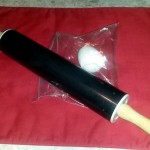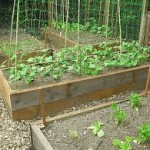Early in our marriage, my wife and I started gardening. We lived in town on a small lot but it gave us an excuse to get outside. During each spring we made the pilgrimage to the local hardware store or greenhouse to pick up seeds, starter plants, fertilizer and soil. Now, eons later in our lives, we live on land with room to grow about whatever we want. My wife still makes out the list of items to pick up but as the years have passed, the list has shrunk. The more time I spent driving into town and loading dozens of 40 lbs bags of powdery dirt into my truck, the more I realized there are better ways to prep a garden. People, even 50 years ago, didn’t spend three times the cost of the produce in peripherals before they even put a seed in the ground. My wife believed if it came from the greenhouse then it must be good dirt. Yes, that is likely true. It is also true that the black mulchy dirt just inside our timber line is just as good, and without a doubt 100% organic. She had her epiphany and ran with it, but I digress. While you sit in your house staring out the the window into winter pergatory and marking the days with a knife on the table, there are things you can do to prep for the growing season without even putting on a coat.
Eggs shells and coffee grounds are in most every cupboard and icebox in America as well as every kitchen trash can. But it has become fairly common knowledge among those with the alleged green thumbs, that coffee grounds are rich in nitrogen and a fantastic supplement to garden soil. They hold a ph somewhere around 6.5. Whether you add it to a compost pile or use it as a separate application to the topsoil, it is a very beneficial and organic, and didn’t I mention it was free? When adding to our compost collection, we simply try to mix it in with the dead grass, vegetation, leaves and whatever else you rake up. You can actually throw most paper coffee filters in there as well for good measure, but keep the pot in your hand. Flip that mess over a couple times each month to keep it cooking properly.
Eggs as well, can provide a cheap and healthy boost to your flowers and produce and has nature’s seal of approval. Eggs contain a great resource of calcium and can be used in a variety of ways. They do not break down quickly; a shell simply broken in your hand can remain in that condition for several years. The smaller the pieces, the quicker they will become one with the soil.  The method we use is to just place them in a clear plastic bag and crush them using a rolling pin. Doesn’t take very long and justifies why you keep that thing in the drawer and never use it. I’ve read online articles where folks will grind eggshells up in a blender, food processor, etc. It works, but I would advise that if you go that way, buy a second hand blender at a flea market. My experience is that the really small bits of the shell can be difficult to clean out of a blender, and I prefer not to find them later in my smoothie. There is no perfect science to the application. Some gardeners will sprinkle the bits of shell over the topsoil; others may blend it into the dirt. It continues to fertilize your garden long after you apply it. You can think of the eggshell bits as a sort of time release bouillon cube.
The method we use is to just place them in a clear plastic bag and crush them using a rolling pin. Doesn’t take very long and justifies why you keep that thing in the drawer and never use it. I’ve read online articles where folks will grind eggshells up in a blender, food processor, etc. It works, but I would advise that if you go that way, buy a second hand blender at a flea market. My experience is that the really small bits of the shell can be difficult to clean out of a blender, and I prefer not to find them later in my smoothie. There is no perfect science to the application. Some gardeners will sprinkle the bits of shell over the topsoil; others may blend it into the dirt. It continues to fertilize your garden long after you apply it. You can think of the eggshell bits as a sort of time release bouillon cube.
Egg shells have also been used successfully as plant start containers. A half shell with a little soil, placed into the original egg carton is free, natural and disposable. Set them on a window sill or table next to the glass just as you would with store bought containers. When it is time to transplant, just move the shell holding the plant directly into the ground. Egg shells do not spoil or “go bad”. They won’t start to stink up the house, but you might want to wash them beforehand if you have any concern over bacteria from the contents.
“Egg juice” and “egg milk” are a few names we call the potion we created for spraying plants. We take crushed shells and put them inside a milk jug and fill it with water. After letting them sit for a couple of days we end up with a nice milky mixture of calcium and water that we will transfer into a watering can. We do a lot of container and raised bed type gardening and usually mixing about a cup of the solution to a gallon of water per treatment is about all we need to use for a small area of plants. The shells by the way, are reusable.
While there are plenty of tips and tricks on line regarding how to keep insects and pests off of your plants, and we use several, one method we have found to be very successful is simply laying out broken egg shell pieces around plants such as tomatoes, lettuce, peppers, broccoli. Snails, slugs and other assorted vile beasts bent on dining locally and after hours at your place find the sharp edges of the shell to be cutting and dangerous to their health. A snail may think it is rude, but it works and it is easy.
In my mind I am a master gardener bar none. In reality, I’m a hobbyist slash amateur who is cheap as hell and always on the lookout for ways to save money and repurpose my trash. Our gardens don’t tower over the land like a cluster of giant green redwoods and I don’t expect I’ll be posting 200 lb Beef Steak tomatoes anytime soon. I have noticed though, that we used to have small, average looking vegetables that were slightly inferior to what you could find at walmart, using the best chemical enhancing sprays, granules, powders and solutions I could buy. Using organic methods, and tips such as these, have really paid off and now I’m only washing bug poop and dust from my beets and lettuce instead of agent pink or some third eye producing chemical from the sci fi channel. Here’s hoping you have a bountiful harvest.
TMP

















